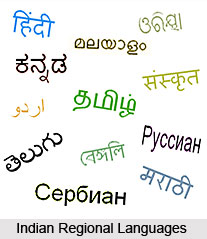 India is an enormous land of ancient culture and ritualistic heritage, which is further heightened by the fact that the land has been enriched by all things natural and innate. Each of India`s physical, political, administrative, economic, humanitarian or social condition has impacted deeply upon its colossal population. Since Indian Independence the country came face to face with what is known as democratic and secular principles, making its residents reside side and side with peace and authority. This very aspect takes on new and meaningful beliefs and thoughts when it is witnessed that humankind speak and communicate in umpteen languages and diction styles. Indeed Indian languages comprise several regional dialects, many of which have been accredited by the Constitution of India. Indian regional languages and the impeccable way of verbalising them, make them stand out in assorted manners, constituting an attractive subject in universities overseas.
India is an enormous land of ancient culture and ritualistic heritage, which is further heightened by the fact that the land has been enriched by all things natural and innate. Each of India`s physical, political, administrative, economic, humanitarian or social condition has impacted deeply upon its colossal population. Since Indian Independence the country came face to face with what is known as democratic and secular principles, making its residents reside side and side with peace and authority. This very aspect takes on new and meaningful beliefs and thoughts when it is witnessed that humankind speak and communicate in umpteen languages and diction styles. Indeed Indian languages comprise several regional dialects, many of which have been accredited by the Constitution of India. Indian regional languages and the impeccable way of verbalising them, make them stand out in assorted manners, constituting an attractive subject in universities overseas.
At present there exist 844 regional Indian language dialects. Each state additionally possesses its own language, which by and large acts as its official language. The 8th schedule of the Constitution of India has enlisted 22 such regional languages. Chapter II of Part XVII of the Indian Constitution states about the utilisation of regional languages of India.
The articles of this chapter are as follows:
Article 345: This article deals with the topic of official language or languages of a State. It is observed that the legislature of each Indian state possesses the power to choose one or more regional languages or Hindi to be used for its official purposes.
Article 346: This article deals with usage of official languages for communicational intensions between one state and another or between a state and the union. It states that the official language chosen by the legislature of a state should be the official language for inter-state communication or communication within a state and the union.
Article 347: This article cites the exceptional provision associated with language spoken by a section of the population of a state. It is also assigned that the President of India can commend any language to be used by a particular portion of the population of a state. This language can further be officially recognised throughout the state.
However, leaving behind all such lawful and strictly administrational news from the Central Government of India, regional languages in India can be consciously divided into six essential sections, comprising - North Indian Languages, South Indian Languages, East Indian Languages, West Indian Languages, Central Indian Languages and North East Indian Languages. Each of these social sections possesses their significant dissimilarity in daily life, beginning from communication and concluding perhaps in dressing styles. North Indian languages assimilate the Hindustani lingua franca, an assorted range of western and eastern Hindi dialects, Punjabi, Sindhi, Pahari languages and Kashmiri. East Indian languages comprise Bihari languages encompassing Bhojpuri, Magadhi and Maithili, various dialects of Bengali, Sikkimese and Oriya. North East Indian languages include Assamese, Nepali, Manipuri or Meiteilon, Kokborok or Tripuri, Nagamese, Mizo, Khasi, Garo, Bodo, Karbi, Dimasa, Mishing and Apatani. South Indian languages comprise one of the five Dravidian languages of Kannada, Malayalam, Tamil, Telugu and Tulu. West Indian languages comprise primarily Marathi and Gujarati, besides the domination of various dialects of Hindi. Central Indian language fashion is predominated by Hindi as their official language, besides Sindhi serving to a section of society.
Apart from the twenty two regional languages stated by Indian Constitution as official, there exist many languages and dialects employed by a number of people. Some of the regional languages and dialects of India encompass - Aariya, Adi, Andaman Creole Hindi, Andh, Arakanese, Awadhi, Bhadrawahi, Bhattiyali, Bhojpuri, Bilaspuri, Birhor, Braj Bhasha, Chaura, Chhattisgarhi, Deccan, Deori, Dhodia, Dimasa, Gaddi, Garhwali, Godwari, Gujari, Gurung, Haryanvi, Holiya, Jad, Jarawa, Kanauji, Khasi, Korlai Creole Portuguese, Kumauni, Ladakhi, Lepcha, Lodhi, Majhi, Malapandaram, Maldivian, Marwari, Mundari, Newar, Parsi, Powari, Rabha, Rajbanshi, Rongpo, Samvedi, Saurashtra, Shekhawati, Sherpa, Tamang, Urali, Varhadi-Nagpuri, Vasavi, Wagdi, Yerukula and Zangskari.



















